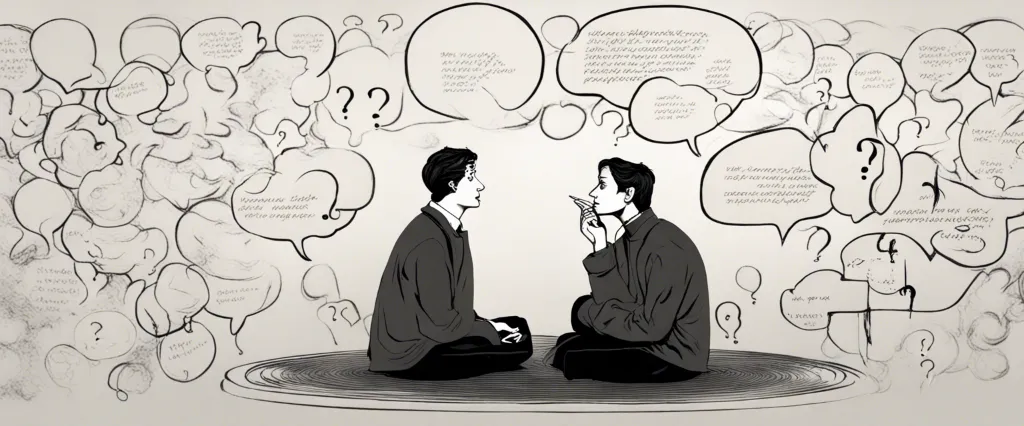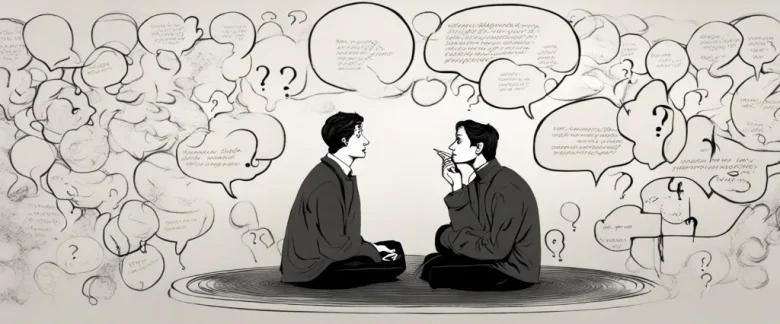
In “Asking the Right Questions,” M. Neil Browne provides readers with a practical and comprehensive guide to sharpening their critical thinking skills. This book equips individuals with the cognitive tools needed to analyze and evaluate information effectively, allowing them to make more informed decisions in their personal and professional lives. As a renowned professor at Bowling Green State University, M. Neil Browne is highly regarded for his expertise in critical thinking and teaching methodologies. With extensive experience in philosophy and psychology, Browne has developed a systematic approach to help readers navigate complex issues and think critically about various perspectives. Through his engaging writing style and insightful examples, Browne empowers readers to ask thoughtful questions, challenge assumptions, and seek the truth amid a sea of information and opinions.
Chapter 1: The Importance of Critical Thinking
In Chapter 1 of “Asking the Right Questions” by M. Neil Browne, the author discusses the significance of critical thinking and its relevance in our everyday lives. Browne highlights that critical thinking goes beyond simply accepting information and ideas at face value; it involves actively questioning, analyzing, and evaluating these ideas to make informed conclusions.
The author emphasizes the importance of critical thinking in personal and professional settings, presenting numerous examples that demonstrate how it can enhance decision-making abilities and problem-solving skills. Browne argues that critical thinkers are more likely to make better choices and avoid falling into common cognitive pitfalls such as biases and fallacies.
Furthermore, the chapter explores the benefits critical thinking offers in democratic societies. Browne stresses that citizens need critical thinking skills in order to make informed decisions about political candidates, policies, and societal issues. By critically examining information from various sources, individuals can better discern between reliable and unreliable sources and avoid getting misled by false or manipulative information.
The chapter also introduces the elements and standards of critical thinking. Browne presents a framework consisting of eight elements: purpose, question, information, interpretation and inference, concepts, assumptions, implications, and point of view. Additionally, he outlines the intellectual standards that can be used to evaluate the quality of thinking, including clarity, accuracy, precision, relevance, depth, breadth, logic, and fairness.
In conclusion, Chapter 1 of “Asking the Right Questions” underscores the importance of critical thinking as a foundational skill for effective decision-making, avoiding cognitive biases, and engaging responsibly in a democratic society. By equipping readers with the elements and standards of critical thinking, the book encourages individuals to question, evaluate, and challenge ideas in order to arrive at better outcomes.
Chapter 2: Clarifying the Question
Chapter 2 of “Asking the Right Questions” by M. Neil Browne delves into the importance of clarifying the question when engaging in critical thinking. The chapter highlights how a vague or ambiguous question can lead to inaccurate or incomplete conclusions.
The author emphasizes that critical thinking is only as effective as the question being asked. He stresses that without a clear and well-defined question, the analysis and evaluation process may become futile. Browne explains that clarifying the question involves identifying key terms and understanding their meanings, interrogating the question itself, and determining the purpose or objective behind it.
The chapter provides several strategies for clarifying questions. One such strategy is to determine the scope of the question by asking who or what is implied in the question, identifying any time limitations, and assessing the context in which the question is being asked. Additionally, identifying any inherent assumptions or biases within the question is crucial to uncovering hidden agendas or misleading information.
The author also highlights the importance of identifying whether a question is descriptive or evaluative. Descriptive questions seek to understand and gather information about a particular subject, while evaluative questions require judgments and assessments based on evidence.
Overall, Chapter 2 emphasizes the significance of clarifying questions as the foundation of critical thinking. By investing time and effort into understanding the question and ensuring its clarity, individuals can avoid misconceptions, develop accurate conclusions, and make informed decisions.
Chapter 3: Gathering Information
Chapter 3: Gathering Information of the book “Asking the Right Questions” by M. Neil Browne focuses on the critical skill of gathering information in order to make well-informed decisions. The chapter begins by highlighting the importance of actively seeking out relevant information and being aware of potential biases that can hinder objective judgment.
The chapter emphasizes that information gathering should involve a careful evaluation of sources to determine their credibility and reliability. Browne stresses that not all information sources are created equal, and it is crucial to consider factors such as expertise, reputation, and potential biases when evaluating the reliability of a source. He encourages readers to utilize a variety of sources, including diverse perspectives, to avoid falling into the trap of confirmation bias.
The chapter also introduces the concept of “selective perception,” which refers to the tendency of individuals to only perceive and pay attention to information that aligns with their preexisting beliefs. To combat this, Browne suggests actively seeking out information that challenges one’s own viewpoint to foster a more well-rounded understanding of the issue at hand.
The chapter concludes with a discussion on the importance of paying attention to how statistics are used and manipulated, encouraging readers to critically evaluate the data presented to them. Browne stresses the significance of understanding the context and limitations of statistical evidence to avoid being misled.
Overall, Chapter 3 highlights the importance of gathering information from reliable sources, actively seeking out diverse perspectives, and critically evaluating data in order to make informed and unbiased decisions. By honing one’s information gathering skills, individuals can improve their ability to ask the right questions and avoid common pitfalls that hinder effective decision-making.
Chapter 4: Evaluating Information and Sources

Chapter 4 of the book “Asking the Right Questions” by M. Neil Browne, titled “Evaluating Information and Sources,” provides readers with guidelines and strategies for critically evaluating the credibility and reliability of information sources.
The chapter begins by emphasizing the importance of critically examining the sources of information in order to make informed decisions. It discusses the two types of sources: primary sources, which are firsthand accounts or original research, and secondary sources, which interpret or analyze primary sources.
Browne introduces several critical questions to aid readers in evaluating the reliability of sources. One such question evaluates the expertise of the source. It encourages readers to assess the qualifications, credentials, and experience of the author or organization behind the information.
Additionally, the chapter delves into the notion of bias, both conscious and unconscious, in sources. It urges readers to identify any potential biases that may influence the information being presented. Browne emphasizes that being aware of biases can help readers evaluate the credibility and objectivity of the source.
The chapter also emphasizes the importance of evaluating the currency of information. It advises readers to consider the publication date and determine if the information is up to date and relevant to their decision-making process.
Lastly, the chapter covers the evaluation of both online and traditional sources. It provides tips for assessing the reliability of online sources, emphasizing the importance of verifying information from multiple credible sources.
In summary, Chapter 4 of “Asking the Right Questions” guides readers on evaluating information and sources, focusing on expertise, bias, currency, and credibility. By critically examining sources, readers can make more informed decisions and avoid being misled by unreliable or biased information.
Chapter 5: Recognizing Assumptions and Biases
Chapter 5 of “Asking the Right Questions” by M. Neil Browne focuses on the importance of recognizing assumptions and biases when engaging in critical thinking. The chapter emphasizes how these factors can shape our perspective and affect the conclusions we draw.
The chapter begins by defining assumptions as underlying beliefs or ideas that we take for granted without questioning them. Assumptions can be influenced by various factors, such as personal experiences, cultural background, and beliefs, and they can heavily impact our thinking and decision-making processes. The author suggests that identifying and assessing these assumptions is crucial for developing a well-rounded and unbiased perspective.
The chapter then proceeds to explore biases, which are similar to assumptions but typically involve a prejudice or preference towards a particular viewpoint or outcome. Browne explains that biases can be influenced by various factors, including emotions, stereotypes, and prior knowledge. He highlights the importance of being aware of our biases to prevent them from clouding our judgment and distorting our critical thinking.
Furthermore, Browne provides readers with practical tips for recognizing assumptions and biases. He explains that questioning our own beliefs and being open to alternative viewpoints is fundamental to challenging our assumptions. Additionally, he advocates for seeking out diverse perspectives and actively engaging in dialogue to broaden our understanding and minimize biases.
In conclusion, Chapter 5 of “Asking the Right Questions” stresses the significance of recognizing assumptions and biases in critical thinking. By acknowledging and questioning these factors, individuals can develop a more well-informed and objective approach to reasoning and decision-making.
Chapter 6: Avoiding Logical Fallacies
Chapter 6 of “Asking the Right Questions” by M. Neil Browne delves into the concept of logical fallacies and how to avoid them. Logical fallacies are errors in reasoning that can mislead and hinder critical thinking.
The chapter starts by highlighting the importance of recognizing logical fallacies, as they commonly appear in everyday conversations, speeches, news articles, and advertisements. Fallacies can manipulate emotions, distort facts, and undermine rational thinking. Browne emphasizes that identifying fallacies is crucial for effective communication and decision-making.
The author then discusses several common types of logical fallacies. These include the straw man fallacy, where an argument misrepresents an opponent’s position to make it easier to attack; the ad hominem fallacy, where an argument attacks a person’s character rather than addressing their argument; and the slippery slope fallacy, where an argument assumes that one event will inevitably lead to a chain of catastrophic events.
To avoid falling into logical fallacies, Browne suggests applying critical thinking skills, such as carefully examining the premises and evidence supporting an argument, as well as considering alternative explanations. He advises keeping emotions in check and focusing on the logical validity of the arguments rather than personal feelings or biases.
Furthermore, the chapter discusses the importance of recognizing when logical fallacies are intentionally employed in persuasive techniques. Understanding these tactics can help individuals become more skeptical and discerning consumers of information.
In summary, Chapter 6 of “Asking the Right Questions” emphasizes the significance of identifying and avoiding logical fallacies. Browne provides examples of common fallacies and offers strategies for critical thinking to counteract them. By becoming aware of these fallacies and using logical reasoning, individuals can enhance their ability to engage in thoughtful discussions, make informed decisions, and effectively analyze arguments.
Chapter 7: Making Informed Decisions
Chapter 7 of the book “Asking the Right Questions” by M. Neil Browne is titled “Making Informed Decisions.” This chapter focuses on the importance of critical thinking in decision-making and provides guidelines for making informed decisions.
The chapter begins by highlighting the significance of decision-making in every aspect of our lives, whether personal or professional. It emphasizes that the quality of our decisions has a direct impact on the outcomes we experience. Browne argues that informed decisions are based on thorough analysis, considering multiple perspectives, and assessing potential biases.
To make informed decisions, Browne suggests following a step-by-step process. The first step is to recognize the need for a decision and identify the problem or objective at hand. Next, he advises gathering relevant information from reliable sources to understand the context and possible options. The author emphasizes the importance of exploring various viewpoints and being open to alternative solutions.
Once the necessary information is gathered, the third step involves evaluating the options by considering the costs, benefits, and potential outcomes. Browne highlights the significance of considering both short-term and long-term consequences.
The final step focuses on reflecting on the decision-making process itself. Browne suggests reviewing the process to identify any biases, fallacies, or errors that may have influenced the decision. By reflecting on the process, individuals can learn from their mistakes and improve their decision-making skills.
In summary, Chapter 7 of “Asking the Right Questions” emphasizes the significance of informed decision-making. It provides a step-by-step approach that involves recognizing the need for a decision, gathering relevant information, evaluating options, and reflecting on the decision-making process. By following these guidelines, individuals can make informed decisions that are more likely to lead to favorable outcomes.

Chapter 8: Applying Critical Thinking in Daily Life
Chapter 8 of “Asking the Right Questions” by M. Neil Browne explores the practical application of critical thinking in our daily lives. The chapter starts by emphasizing the importance of applying critical thinking skills to real-world situations, as it enables us to make informed decisions, evaluate arguments more effectively, and avoid being manipulated or deceived.
One of the main topics covered in the chapter is recognizing and analyzing the use of rhetorical devices, such as euphemisms, analogies, and stereotypes. Browne highlights that these devices are commonly used in advertising, politics, and interpersonal communication to influence our thoughts and actions. By being aware of these strategies, we can better assess the credibility of arguments and separate facts from persuasive language.
The chapter also emphasizes the significance of recognizing logical fallacies. Logical fallacies are flaws in reasoning that can mislead or deceive us. Browne provides examples of various fallacies, including ad hominem attacks (personal attacks instead of addressing the argument), straw man arguments (misrepresenting or exaggerating an opponent’s argument), and appeal to authority (relying on the opinions of experts without considering the evidence). Understanding fallacies helps us identify weak arguments and avoid making decisions based on faulty reasoning.
Additionally, Browne explains the concept of decision-making traps. These traps are common patterns of thinking that can hinder our ability to make rational choices. For instance, being influenced by emotions or personal biases, relying solely on past experiences, or succumbing to peer pressure can all lead to poor decision-making. By recognizing and avoiding these traps, we can make more thoughtful and unbiased decisions.
In conclusion, Chapter 8 highlights the practicality of critical thinking skills in our daily lives. The ability to spot and evaluate rhetorical devices, logical fallacies, and decision-making traps enables us to make more informed decisions, resist manipulation, and think critically about the information presented to us in various contexts.
After Reading
In conclusion, “Asking the Right Questions” by M. Neil Browne offers a comprehensive guide to critical thinking and improving our decision-making skills. The book teaches readers how to identify and challenge assumptions, evaluate evidence, analyze arguments, and develop their own reasoning abilities. Throughout the chapters, Browne equips readers with practical strategies and techniques to avoid common pitfalls in thinking and make more informed choices. By emphasizing the importance of asking thought-provoking questions and seeking reliable information, Browne helps readers develop a more thoughtful and rational mindset. Overall, “Asking the Right Questions” serves as a valuable resource for anyone looking to enhance their critical thinking abilities and make more sound judgments in various aspects of life.
1. Made to Stick: Why Some Ideas Survive and Others Die” by Chip Heath and Dan Heath – This book explores the elements that make ideas resonate and stick in people’s minds. It delves into what makes some stories, concepts, or messages memorable, promoting effective communication and persuasion.
2. Influence: The Psychology of Persuasion” by Robert B. Cialdini – Drawing from extensive research, this book uncovers the principles behind influence and persuasion. It examines various psychological tactics used by advertisers, salespeople, and others to sway people’s decisions, making it an enlightening read for anyone interested in understanding human behavior and decision-making.
3. The Art of Thinking Clearly” by Rolf Dobelli – In this enlightening book, Dobelli explores the common cognitive biases and logical fallacies that often hinder our decision-making. By highlighting these mental traps and offering practical strategies to avoid them, the author guides readers towards clearer, more rational thinking.
4. Nudge: Improving Decisions about Health, Wealth, and Happiness” by Richard H. Thaler and Cass R. Sunstein – This book introduces the concept of “nudging,” where small, subtle changes in the presentation of choices can significantly impact people’s decisions. It explores ways to create a “choice architecture” that guides individuals towards making better choices, leading to improved outcomes in various aspects of life.
5. Predictably Irrational: The Hidden Forces That Shape Our Decisions” by Dan Ariely – Ariely, a behavioral economist, delves into the irrational aspects of human decision-making. Through entertaining experiments and real-life examples, he reveals the underlying psychological forces that often lead us astray, providing intriguing insights to help readers make smarter decisions in their own lives.



